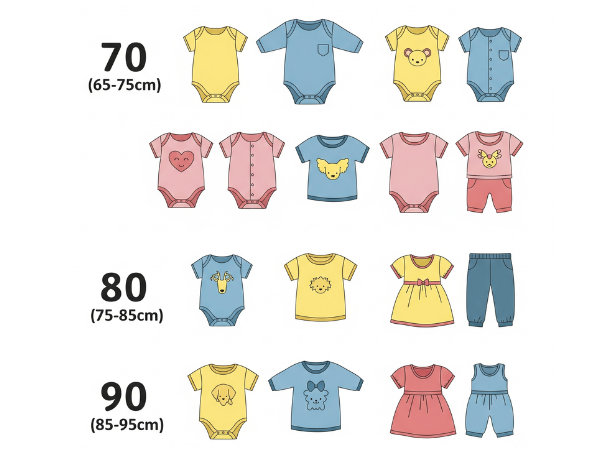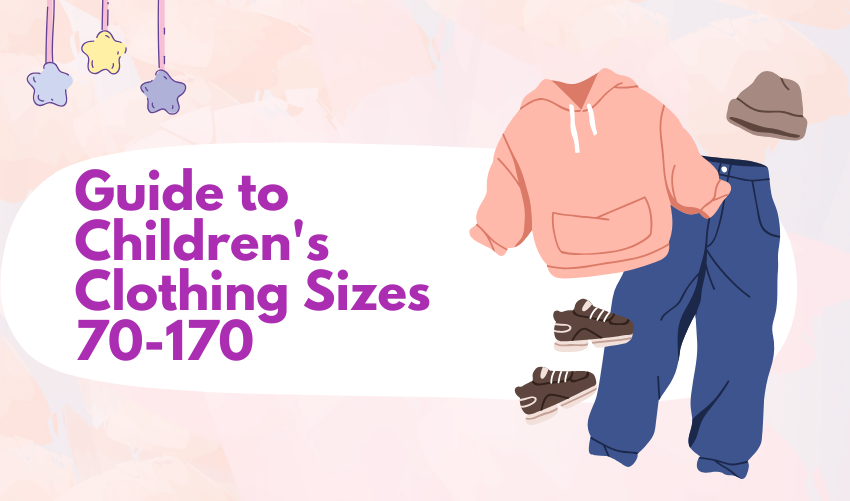Finding the right clothing size for your child can feel like solving a puzzle. You want to make sure they’re comfortable and look great, but navigating the numbers can be confusing.
Sizes 70-170 cover a wide range, and knowing which one fits your child best involves more than just guessing. This guide breaks it all down by age and height, giving you a clear path to making smart choices.
Understanding Children’s Clothing Sizes
This guide breaks down these sizes by age and height, offering a clear path through the maze of children’s clothing. By focusing on key measurements and understanding why sizes vary, you can make informed choices for your child’s wardrobe.
Why Sizing Varies
One of the biggest challenges in children’s clothing is the lack of a universal standard. Different regions, such as the US, EU, and Asia, use varying sizing systems. This means a size in one country might not match the same size in another.
Here are some reasons why sizing varies:
- Brand Discrepancies: Even within the same sizing system, sizes can vary between brands.
- Age vs. Height: Some use age to suggest size, but children grow at different rates. So age alone isn’t accurate.
- Age is Just a Guide: Age is not a precise measure due to varying growth patterns in children.
Let’s consider a simple table to illustrate the variation:
| Region | Size System |
|---|---|
| US | Age-Based |
| EU | Height-Based |
| Asia | Mixed (Age & Height) |
Understanding these differences can help you choose the right fit for your child.
The Importance Of Measurements
Focusing on key measurements is essential when selecting children’s clothing. Instead of relying solely on age, consider height, chest, waist, and hip circumference. These measurements provide a more accurate picture of what will fit.
Here are some critical points to keep in mind:
- Height: Often the most reliable measurement for sizing.
- Chest, Waist, and Hip Circumference: Ensure clothes fit comfortably and allow movement.
- Growth Spurts: Always consider recent growth when buying clothes.
It’s wise to measure your child periodically, especially during growth spurts. A flexible tape measure can help ensure accuracy. Record these measurements and compare them with the size charts provided by brands.
Decoding Sizes 70-170 (Primarily Height-Based)
The sizes 70-170 are primarily based on height, making it easier to determine the best size for growing children. This guide breaks down these sizes according to age and height, helping parents navigate their children’s clothing needs effortlessly.

Baby & Toddler Sizes (70-90)
Babies grow quickly, and choosing the right clothing size can be challenging. The size range from 70 to 90 caters to infants and toddlers, ensuring comfort and mobility.
- Size 70: Typically for infants around 3-6 months, fitting heights of 65-75 cm. Perfect for newborns transitioning from infant wear.
- Size 80: Generally fits babies aged 6-12 months, with heights between 75-85 cm. Ideal for crawling and early walking stages.
- Size 90: Often for toddlers aged 12-24 months, accommodating heights of 85-95 cm. Suitable for active toddlers exploring their world.
Consider the child’s growth rate and activity level when selecting sizes in this range. A table of measurements can assist:
| Size | Age | Height (cm) |
|---|---|---|
| 70 | 3-6 months | 65-75 |
| 80 | 6-12 months | 75-85 |
| 90 | 12-24 months | 85-95 |
Preschool & Early School Ages (100-130)
Preschoolers and early school-aged children have unique needs as they become more active. Clothing sizes from 100 to 130 are designed to accommodate these developmental changes.
- Size 100: Corresponds to approximately 2-3 years, fitting heights of 95-105 cm. Perfect for playful preschoolers.
- Size 110: Often for children aged 3-4 years, suitable for heights of 105-115 cm. Provides room for growth and movement.
- Size 120: Generally fits kids aged 5-6 years, with heights of 115-125 cm. Ideal for school activities and play.
- Size 130: Typically for children aged 7-8 years, accommodating heights of 125-135 cm. Ensures comfort during school and sports.
Parents should consider the child’s activities and growth spurts. Here’s a helpful size chart:
| Size | Age | Height (cm) |
|---|---|---|
| 100 | 2-3 years | 95-105 |
| 110 | 3-4 years | 105-115 |
| 120 | 5-6 years | 115-125 |
| 130 | 7-8 years | 125-135 |
Older Children & Pre-teens (140-170)
Older children and pre-teens require clothing that matches their growing independence and changing bodies. Sizes 140-170 are tailored to meet these needs.
- Size 140: Often for kids aged 9-10 years, fitting heights of 135-145 cm. Suitable for active school days and sports.
- Size 150: Corresponds to approximately 11-12 years, with heights of 145-155 cm. Provides room for growth and style preferences.
- Size 160: Generally fits pre-teens aged 13-14 years, accommodating heights of 155-165 cm. Offers comfort and flexibility for various activities.
- Size 170: Often for older pre-teens or young teens, aged 14-15+ years, with heights of 165-175 cm. Ensures fashionable and comfortable fit.
Understanding the child’s preferences and lifestyle can aid in choosing the right size. A reference table can help:
| Size | Age | Height (cm) |
|---|---|---|
| 140 | 9-10 years | 135-145 |
| 150 | 11-12 years | 145-155 |
| 160 | 13-14 years | 155-165 |
| 170 | 14-15+ years | 165-175 |
Practical Tips For Parents
This guide aims to provide practical tips for parents to make shopping easier. By considering specific factors, you can ensure your child is comfortable and well-dressed.
Always Check The Size Chart
Every brand’s chart is unique; always consult it. This is the golden rule when buying clothes for your child. Brands often have different sizing systems, which can lead to confusion. To avoid this, take the time to familiarize yourself with the size chart provided by each brand.
Here are some practical steps to follow:
- Measure Your Child: Use a tape measure for accurate height, chest, and waist measurements.
- Brand Specifics: Note that some brands might fit larger or smaller than others.
- Read Reviews: Other parents’ experiences can offer valuable sizing insights. They can highlight if a brand’s sizing is true to size or not.
To avoid this, take the time to familiarize yourself with the size chart provided by each brand.
Consider The Garment Type
The type of garment greatly influences the size you should choose. Different clothing types require different sizing considerations.
- Outerwear: Buy a size up to allow for layers and growth. This is essential for jackets and coats, ensuring your child stays warm.
- Footwear: Ensure proper fit to support foot development. Shoes that are too small can hinder growth, while too large can cause accidents.
- Sleepwear: Often designed to be snug for safety; check specific regulations. This ensures comfort and reduces fire hazards.
It’s crucial to evaluate each garment’s purpose and fit before purchasing. This helps in selecting the right size, ensuring comfort and longevity. Always prioritize your child’s comfort and safety over fashion trends.





Leave a Reply